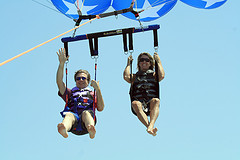5 Tips for Insuring Adventure Travel
1 March 2014
In August 2013, an Adventure Tourism Market Study by George Washington University indicated huge growth in the adventure travel sector. Specifically, adventure travel has been growing 65% year over year since 2009. It is now a $263 billion industry. The study indicated a difference between ‘hard’ adventure and ‘soft’ adventure, described briefly as follows:
- Hard adventure includes trekking, climbing (mountain, rock, and ice) and caving. These activities are considered high risk and require a high level of skill.
- Soft adventure includes all other tourism activities.
The study’s definitions aside here’s something that might surprise you – lots of activities you can do on cruise ships and at resorts around the world are considered adventure activities by your travel insurance company.
Nearly all travel insurance plans specifically exclude coverage for activities that are considered riskier – for obvious reasons – and this means that you could be left paying your own medical bills if you participate in something pretty common and get hurt.
Here’s an example from the Travelex Travel Select plan’s description of coverage to explain:
The following exclusion applies to all coverages:
We will not pay for any loss under the plan, caused by,
or resulting from:
mountain climbing, bungee cord jumping, skydiving,
parachuting, hang gliding, parasailing or travel on
any air supported device, other than on a regularly
scheduled airline or air charter company;”
Some travel insurance plans cover skiing, and some do not. Some cover SCUBA diving to a certain depth and others exclude it completely. Plus, even if the activity is not specifically listed as excluded, you cannot assume it is covered.
The medical expenses from a parasailing accident, for example, can be quite expensive, especially if you have traveled outside your own health insurance network. What does this mean for you?
1. You Must Read the Plan’s Description of Coverage
You must carefully review your travel insurance policy’s description of coverage to know what activities are excluded from coverage BEFORE you participate in them, or you could be paying the consequences.
Reading the plan’s brochure and online description is not enough – the exclusions are specifically listed in the description of coverage. In this particular case, your concern is about the exclusions. Do this quickly too, because the free look period is only 10-15 days on average and after that, your plan cannot be canceled or modified.
2. You May Need a Higher Medical Limit
When you find a plan that covers your planned adventure activity, you should double-check the details about medical coverage. In some cases, the plan will have a relatively low medical limit for injuries sustained while participating in adventure activities.
Read your plan’s description of coverage thoroughly to be sure you’ll have enough medical and evacuation protection to pay for an emergency.
3. An Accident Could Mean a Medical Evacuation is Necessary
Only travel insurance plans and specialized medevac plans offer coverage for evacuations, and if the activity you participate in goes awry and you are badly injured and need to be evacuated to receive medical treatment, you will want coverage. Medical evacuations are very expensive and difficult to arrange, but your travel insurance provider will not only arrange, coordinate, and pay for your safe evacuation, they will also fly you home after your condition is stable.
Remember that evacuation coverage is usually combined with repatriation, which is the coverage that helps your family recover your body and return it home for burial. Repatriation expenses are not as high as evacuations but can easily cost $5,000 or $10,000 and this is not an expense you want your family to have to pay.
4. You Cannot Count on Cruise Insurance or Credit Card Protection
Neither your cruise insurance nor your credit card protection will cover adventure sports either. The only coverage you can get for adventurous activities is through a travel insurance company and usually by buying the optional sports waiver or added coverage.
Even though the cruise line offers SCUBA diving as an activity, for example, their insurance plans won’t pay for your medical care if you have a severe reaction to a jellyfish sting, example. They’ll get you to the onboard medical facility where you will have to add the charges to your credit card bill at the end of the cruise.
Read our review of Credit Card travel protection vs. Travel Insurance for more details.
5. You May Need Extra Coverage for your Equipment
If you own your own sports equipment, that equipment doesn’t come cheap. Baggage coverage always has per-item limits of $300-$500 (on average) for any single item. This means that if you are taking your own buoyancy compensator vest on a SCUBA trip in the Cayman Islands, you’ll want some extra protection for that sports equipment.
Some travel insurance plans offer extra sports equipment protection – typically up to $1,000 – which you can purchase. Your credit card, in this case, maybe a better bet for protection even in combination with the extra coverage on your travel insurance plan, but you’ll need to review the details of that coverage to see if it will pay out if your equipment is stolen, for example. In some cases, you can use personal property protection in combination with your homeowner’s insurance plan to get coverage for expensive items like sports equipment.
See our review of Adventure Travel Insurance for more details and a list of plans.
Damian Tysdal is the founder of CoverTrip, and is a licensed agent for travel insurance (MA 1883287). He believes travel insurance should be easier to understand, and started the first travel insurance blog in 2006.

